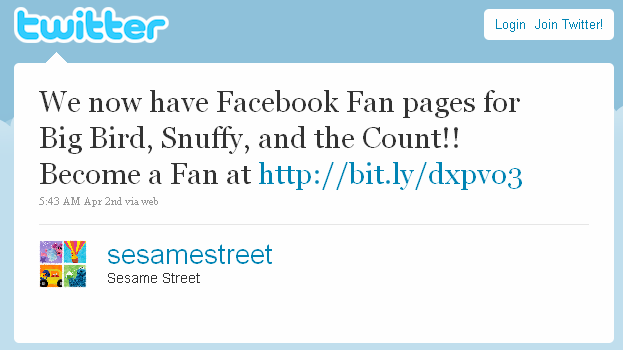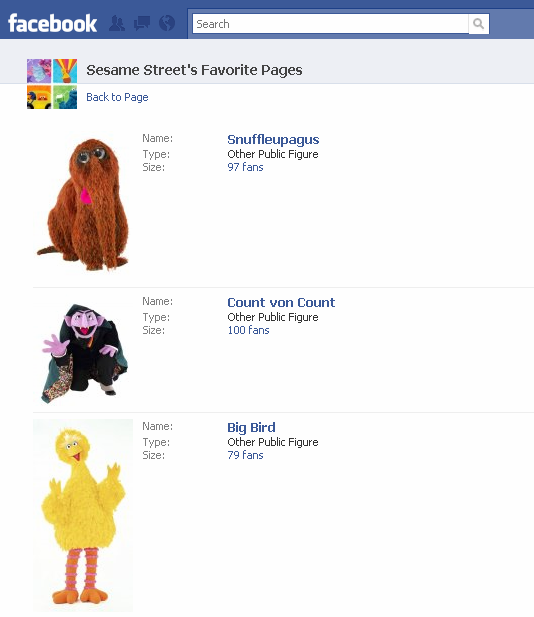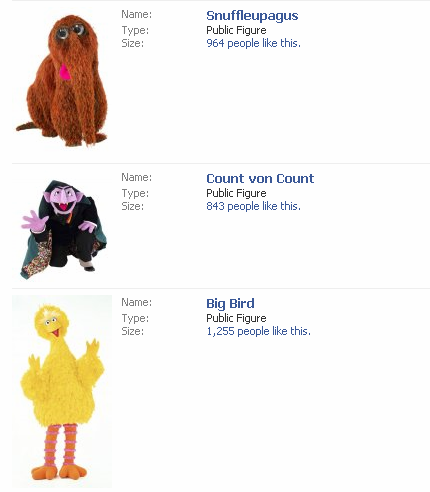I work for Sesame Workshop, the non-profit behind Sesame Street. I’m the Director of New Media Communications, which means, in part, I get to figure out how we use Facebook and Twitter. I have been collecting a lot of publicly available data about one of my projects, and the results have proved interesting.
Earlier this year, we opened up a bunch of official Fan pages (when they were called that) for various characters. We started with Elmo, Cookie Monster, Grover, Bert and Ernie, Rosita, Oscar the Grouch, and Abby Cadabby. Each proved popular, and on March 25th, we invited our then-60,000 plus Twitter followers to become Facebook fans of those characters.

The bitly link did about 550 clicks. Before the tweet, most of the existing character fan pages had fewer Facebook fans than we had Twitter followers by an order of magnitude. Each of these pages fan counts grew by about 10%.
But the more interesting feedback I had to gather by hand. People tweeted at @sesamestreet with their requests. Almost 20 different characters — including human actors and one teddy bear — were suggested. Many characters were suggested by only one or two people, but three characters stood out.
- Big Bird lead the way by a lot. For indexing, say he scored 100.
- He was followed by Snuffleupagus. Using the same index, put him at roughly 75.
- The Count (officially Count von Count) came in third, with an index of 40.
A week or so later, we announced the new pages on Twitter.

I intentionally did not announce it on Facebook because I wanted to see how well our then-70,000 Twitter followers would translate into Facebook fans. It was slow going, taking about 90 minutes to get one of the three characters to 100 fans, despite roughly 650 clicks overall that day. I stopped checking once the first character hit 100 fans.
Given the response to my informal poll, I expected Big Bird to come out to a quick and decisive lead. I was wrong.

Snuffy and The Count were neck and for the 90 or so minutes it took for the latter to prevail. Big Bird was a laggard, not even coming close. It was the exact opposite results of the poll.
Small sample size, perhaps? Maybe I wasn’t hitting the same audiences? Perhaps the responders on Twitter were not also using Facebook? Or maybe they were, but they did not want their Facebook (real?) friends to know they were fans of children’s television characters?
Any are likely explanations, but none are very satisfying. Instead of coming up with some answers, I instead ended up with another question:
Which “survey” was more accurate?
In effect, I conducted two surveys on Twitter. One was an explicit ask: Which character pages would you want to become a fan of? The other — “we’ve created these pages!” — was, implicitly, the same thing. The former was more theoretical while the latter concrete. Which one is better?
Yesterday, I checked these three characters’ pages again. The results changed, reflecting closely the results of the earlier poll:

Indexing Big Bird to 100 again, Snuffy comes in at 77 — not far off from his original Twitter score — and the Count at 67. It makes sense that these are a bit higher because while the Twitter responses naturally limit the # of possibilities (140 characters and the memory/imagination of the responder being two factors), there is no such mutual exclusivity or memory leaks when presented with options on Facebook.
Some general takeaways:
- Twitter followers do not convert to Facebook fans at as high a level as I thought. Cookie Monster, who is obviously incredibly popular on Twitter and the Internet generally, jumped only about 300 fans. That is, about 0.5% of our Twitter followers became Facebook fans of Cookie Monster — a paltry sum.
- Twitter followers may act as a good focus group. While the conversion to Facebook fans for Big Bird, Snuffy, and the Count didn’t come overnight, the original “poll” seemed to accurately predict who would be the most popular. For what it’s worth, Cookie Monster, whose tweets are retweeted with alacrity, has nearly 25,000 Facebook fans — to Big Bird’s 1,250 or so.
- The natural growth of Facebook pages is impressive. We’ve done very little to promote Big Bird’s inclusion on Facebook, yet his Fan count is growing. The same is true for each of the other characters as well.
I’m sure some of that is wrong — and that it’s certainly incomplete.
Pingback: Around the web: Great articles on social media | Small Act